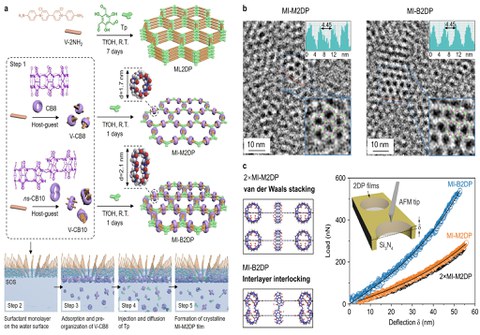13.11.2025
Mechanically interlocked monolayer and bilayer two-dimensional polymers with high elastic modulus
Two-dimensional polymers (2DPs) and their layer-stacked covalent organic frameworks (2D COFs), are a class of crystalline materials exhibiting periodic order in two orthogonal directions. In these organic 2D crystals, adjacent layers are typically stacked by weak van der Waals forces, π–π interactions, or hydrogen bonding. While extensive research has elucidated their in-plane structures and properties, interlayer interactions across the third dimension present an additional, yet less explored, avenue for structural and functional tunability. Controlled stacking into bilayers gives rise to emergent physical and chemical phenomena absent in the monolayer limit, driven by proximity effects such as interlayer electronic coupling and interfacial symmetry breaking. For example, slight rotational misalignment between layers produces moiré superlattices with spatially modulated electronic or excitonic features, while stacking alters the band gap or introduces new states near the Fermi level. Likewise, weak interlayer interactions enable sliding or decoupling between layers, reducing overall mechanical strength. These observations underscore the importance of constructing both monolayer and bilayer 2DPs to probe interlayer structure–property relationships. Top-down approaches, including physical and chemical exfoliation, can yield ultrathin layers, but often suffer from poor structural integrity and non-uniform thickness. In contrast, bottom-up strategies, such as on-surface synthesis and Langmuir-Blodgett techniques, have demonstrated success in producing monolayer 2DPs. However, extending these strategies to bilayer, whether via direct synthesis or layer-by-layer transfer, invariably disrupts structural uniformity, as interlayer interactions and offsets introduce disorder. Therefore, precise control over 2DP thickness from monolayer to bilayer—while preserving well-defined in-plane structures—remains a synthetic challenge.
Figure 1: Schematic illustration of the synthetic procedure for multilayer 2D polymer (ML2DP), mechanically interlocked monolayer and bilayer 2DPs (MI-M2DP and MI-B2DP) on the DMAc-H2O surface. b) TEM images of MI-M2DP and MI-B2DP. c) Mechanical properties of MI-M2DP, 2×MI-M2DP and MI-B2DP measured by AFM nanoindentation.
Copyright for picture:©Springer-Nature (https://www.nature.com/articles/s44160-025-00930-4)
A recent article by researchers from TU Dresden and the Max Planck Institute of Microstructure Physics, published in Nature Synthesis, report the on-water surface synthesis of crystalline mechanically interlocked monolayer and bilayer 2DP (MI-M2DP and MI-B2DP) films by embedding macrocyclic molecules (MCMs) with one and two cavities into 2DP backbones. The incorporation of bulky MCMs introduces periodic mechanical bonds that precisely control interlayer interlocking, enabling selective monolayer or bilayer 2DP formation. Both MI-M2DP and MI-B2DP exhibit homogenous, large-area films with ordered hexagonal pores and high modulus. MI-B2DP demonstrates an exceptionally high effective Young's modulus of 151±16 GPa (indentation method), surpassing MI-M2DP (90±14 GPa), vdW-stacked MI-M2DPs (46±11 GPa), and other reported multilayer 2DPs (< 50 GPa). Modeling confirms that the mechanical interlocking minimizes interlayer sliding and reinforces the structure. This study advances the controlled synthesis of crystalline two-dimensional polymers at the monolayer and bilayer levels, offering new insights and strategies to overcome existing challenges in probing interlayer structure–property relationships.
Acknowledgements: This work was financially supported by the ERC Synergy Grant (2DPolyMembrane, grant no.101167472), ERC Consolidator Grant (T2DCP), GRK2861 (no. 491865171), CRC 1415 (Chemistry of Synthetic Two-Dimensional Materials, no. 417590517), as well as the German Science Council and Center for Advancing Electronics Dresden. R.D. thanks Taishan Scholars Program of Shandong Province (tsqn201909047) and National Natural Science Foundation of China (22272092). Y.Y. gratefully acknowledges funding from the China Scholarship Council. The authors acknowledge the Dresden Center for Nanoanalysis at TUD. The authors thank Dr. P. Formanek for the use of the SEM facility. The GIWAXS experiments were performed at the BL11-NCD-SWEET beamline at ALBA Synchrotron with the collaboration of ALBA staff. The authors would like to thank Dr. M. Malfois for the help in setting up the experiment.
Reference: Ye Yang, André Knapp, David Bodesheim, Alexander Croy, Mike Hambsch, Ilka Hermes, Chandrasekhar Naisa, Darius Pohl, Bernd Rellinghaus, Changsheng Zhao, Stefan C. B. Mannsfeld, Gianaurelio Cuniberti, Zhiyong Wang, Renhao Dong, Andreas Fery, Xinliang Feng, Mechanically interlocked monolayer and bilayer two-dimensional polymers with high elastic modulus, Nat. Synth. 2025, https://www.nature.com/articles/s44160-025-00930-4.
DOI: 10.1038/s44160-025-00930-4
Copyright for picture: ©Springer-Nature (https://www.nature.com/articles/s44160-025-00930-4)
Contact: Ye Yang
+49-015257529565


